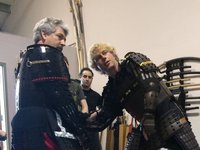HISTORY

History of Bujinkan Budo Taijutsu
Bujinkan Budo Taijutsu, formerly known as Ninjutsu as well as Togakure Ryu Ninpo Taijutsu, has little known and sometimes contradictory history of its origins. It is believed that the martial art predecessor to Ninjutsu came to Japan via China/Tibet with the Buddhist religion about 1300 years ago. For the next four hundred years the martial art was taught to all classes of Japanese (Samurai, nobles, etc.) and was called budo or bugei (warrior skill). During the time of the warring states (a feudal time during the Heian period (~1162) in Japanese history), a battle took place between the Genji and Heiki clans. During this battle a young Genji soldier by the name of Shima Kosanta Minamoto no Kanesda was seriously wounded, rescued by a warrior named Daisuke Nishina (of Togakure village), retreated into the mountains, and was nursed back to health. Daisuke, the founder of Togakure Ninjutsu, took Shima as his second deshi (student). Shima was eventually granted license upon Daisuke's death, and became the second Soke of Togakure Ryu Ninpo Taijutsu.
Ninpo, the warrior mentality of the mountain clans, means 'enduring heart.' It is still written in Japan today using the Chinese characters of a sword piercing the heart, and is meant to inspire the novice: “Though there be a sword piercing your heart, you shall not fail your mission or your clan.” Nin, as expressed by Dr. Hatsumi, can also be referred to as the ability to persevere embarrassment without need of revenge, without ego.
This mentality, combined with stealth, blinding powders, techniques that "hide" in the fight, commando raids and assassinations, and some well-placed rumors of sorcery and ghosts, made the severely outnumbered 'Ninja' a formidable opponent to the warring Samurai. Thus, the clans survived to propagate the fighting skills into an art form.
Not being of the nobility or Samurai classes, the 'Ninja' were often villagers and farmers. Coming from humbled means, and often lacking access to the master weapon makers, many weapons were developed from farm implements, or scavenged from battlefields.
The Ryu or Schools of Martial Arts were kept within the individual clans to ensure the clan's survival and to keep the lineage clear cut. Only the Soke (head of the lineage) knew all the techniques, and only passed on the knowledge when nearing death. Each ryu survived, in part, by keeping its techniques a secret. It wasn't until the period of peace (Edo era), that dojo's, or places of enlightenment, became the standard place of training.
During the Edo era (approximately 250 years of peace from 1600 to 1850), fighting decreased. The Samurai class bugei arts began to be watered down to become less combative and more sporting. Thus, the art of fighting with the sword, Kenjutsu, became "the way of the sword," or Kendo. Akijutsu became Akido, and Jujutsu became Judo. The remaining Japanese fighting arts were eventually organized by an unknown individual into a class called Shinkengata, or 'real combat fighting;' about seventy percent of which came from Kukishinden ryu.
Historically, the scrolls passed on from soke to soke, listed only the names of the techniques, e.g. oni kudaki (crushing the devil). No directions, explanations, or illustrations of the techniques were provided. Until Takamatsu sensei, the previous Grandmaster, all instructions for techniques were passed by voice from soke to soke. For Soke Hatsumi, Takamatsu sensei prepared written and illustrated techniques. Takamatsu sensei was the first soke to learn all nine ryu's. Hatsumi spent 40 years learning the techniques, and he has not taught all of the nine ryu yet.
Soke considers Budo Taijutsu as the Martial Art of distance; as opposed to power and speed. The training integrates combat arts, body awareness techniques (working with rope, weapons), and the mentality of the warrior heart: Ninpo!
